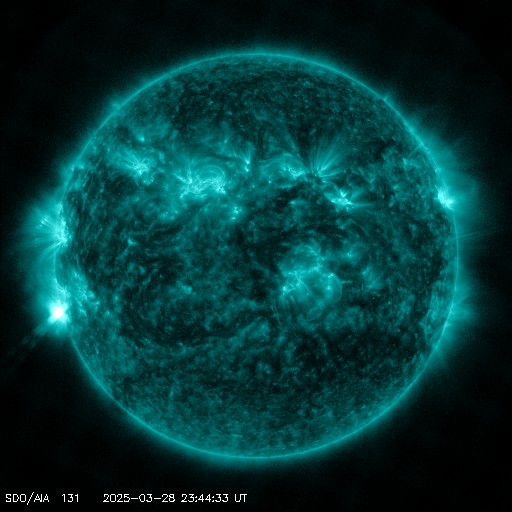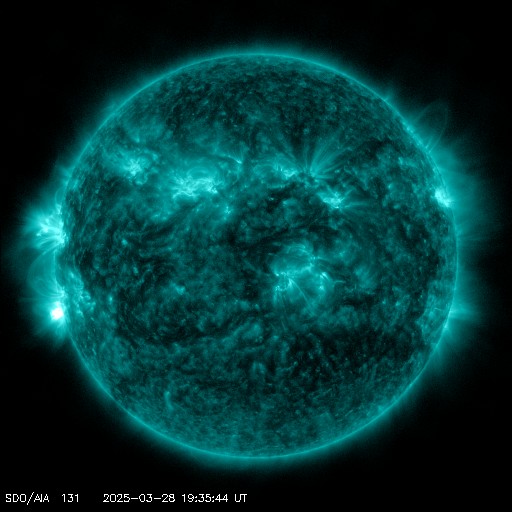Viewing archive of Thursday, 16 August 2001
Solar activity report
Any mentioned solar flare in this report has a scaling factor applied by the Space Weather Prediction Center (SWPC). Because of the SWPC scaling factor, solar flares are reported as 42% smaller than for the science quality data. The scaling factor has been removed from our archived solar flare data to reflect the true physical units.
Report of Solar-Geophysical Activity 2001 Aug 16 2200 UTCPrepared by the NOAA © SWPC and processed by SpaceWeatherLive.com
Joint USAF/NOAA Report of Solar and Geophysical Activity
SDF Number 228 Issued at 2200Z on 16 Aug 2001IA. Analysis of Solar Active Regions and Activity from 15-2100Z to 16-2100Z
Solar activity from numbered regions on the visible
disk was low. Impulsive B- and C-class flares were observed
throughout the period, the largest being an optically uncorrelated
C3 flare at 16/0957 UTC. However, the most impressive activity of
the day was a remarkable backside CME, observed on SOHO/LASCO
starting at about 15/2355 UTC. This event resulted in the proton
enhancements discussed in section IIA below. The observed CME
together with backside imagery inferred from the SOHO/MDI instrument
suggest old Region 9557 (S20, L=283) as the likely source, presently
located near the far backside central meridian. On the visible
disk, three new regions were numbered today: 9583 (S23E13), 9584
(S11E60), and 9585 (N15E74). All appear to be small, simply
structured beta-class groups with low flare activity potential.
IB. Solar Activity Forecast
Solar activity on the visible disk is
expected to persist at mainly low levels for the next three days.
IIA. Geophysical Activity Summary 15-2100Z to 16-2100Z
Geomagnetic field activity has been quiet to unsettled throughout the
period. A major proton event for >= 100MeV protons above 1pfu began
at 16/0105 UTC, followed by >= 10Mev protons above 10pfu at 16/0135
UTC. Maximum flux for 100Mev protons was 29pfu at 16/0305 UTC, and
for 10MeV protons was 493pfu at 16/0355 UTC. Both events remain in
progress, and represent a record response for a presumed CME source
so far behind the western limb as described in section 1A above.
Greater than 2MeV electrons were observed at moderate enhancement
levels again today, although the electron sensor on GOES-8 was
saturated by the proton event for much of the period.
IIB. Geophysical Activity Forecast
The geomagnetic field is
expected to be at active to minor storm levels within 24 hours, in
response to anticipated shock passage from CME activity reported on
August 14th. Isolated major storm periods may also be possible at
higher latitudes, as well as an enhancement of 10MeV proton levels
for the event in progress. Geomagnetic storm activity is expected
to wane during day two, along with the 100MeV proton event. The
10MeV proton event is expected to persist at levels above 10pfu into
day three. Greater than 2MeV electrons are also expected to persist
at moderate enhancement levels.
III. Event Probabilities 17 Aug to 19 Aug
| Class M | 25% | 25% | 25% |
| Class X | 01% | 01% | 01% |
| Proton | 99% | 95% | 90% |
| PCAF | red | ||
IV. Penticton 10.7 cm Flux
Observed 16 Aug 143 Predicted 17 Aug-19 Aug 140/140/145 90 Day Mean 16 Aug 151
V. Geomagnetic A Indices
Observed Afr/Ap 15 Aug 004/009 Estimated Afr/Ap 16 Aug 007/008 Predicted Afr/Ap 17 Aug-19 Aug 025/020-017/015-012/018
VI. Geomagnetic Activity Probabilities 17 Aug to 19 Aug
| A. Middle Latitudes | |||
|---|---|---|---|
| Active | 35% | 30% | 25% |
| Minor storm | 20% | 15% | 10% |
| Major-severe storm | 10% | 05% | 05% |
| B. High Latitudes | |||
|---|---|---|---|
| Active | 40% | 30% | 30% |
| Minor storm | 20% | 15% | 15% |
| Major-severe storm | 05% | 05% | 05% |
All times in UTC
Current data suggests there is a slight possibility for aurora to appear at the following high latitude regions in the near future
Murmansk, VorkutaLatest news
Latest forum messages
AR4046 127Incoming & Unnumbered Active Regions 1657Aurora photography hints for those of us with smartphones 49Large Coronal Hole 25 178LASCO Data Not Updating 5
More topicsSupport SpaceWeatherLive.com!
A lot of people come to SpaceWeatherLive to follow the Sun's activity or if there is aurora to be seen, but with more traffic comes higher server costs. Consider a donation if you enjoy SpaceWeatherLive so we can keep the website online!

Latest alerts
00:00 UTC - Solar flare
Moderate M1.79 flare
Friday, 28 March 2025
23:36 UTC - Radio Blackout
Minor R1 radio blackout in progress (≥M1 - current: M1.04)
21:24 UTC - Hemispheric Power Index
The OVATION model predicts the Hemispheric Power Index to reach 51GW at 21:59 UTC
19:45 UTC - Solar flare
Moderate M1.16 flare
19:27 UTC - Radio Blackout
Minor R1 radio blackout in progress (≥M1 - current: M1.1)
Space weather facts
| Last X-flare | 2025/03/28 | X1.1 |
| Last M-flare | 2025/03/28 | M1.7 |
| Last geomagnetic storm | 2025/03/27 | Kp5 (G1) |
| Spotless days | |
|---|---|
| Last spotless day | 2022/06/08 |
| Monthly mean Sunspot Number | |
|---|---|
| February 2025 | 154.6 +17.6 |
| March 2025 | 128.3 -26.4 |
| Last 30 days | 128.3 -23.7 |




